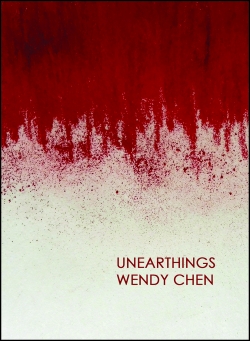Unearthings
by Wendy Chen
reviewed by Calista McRae
“They Sail Across the Mirrored Sea,” a poem near the beginning of Wendy Chen’s Unearthings, imagines the trauma experienced by its speaker’s relatives in rural midcentury China. It opens with a vivid, thingy description of wild shrimp:
No bigger than her smallest finger, they frothed
in the pool—rice-paper shells
bandaged around a bit of milky gray.
Chen sees shrimp as beautiful, weird, and “milky gray”; she comes up with the verb “froth” for their crowded motions; and she surrounds them with food words, seeming to recognize that it is hard to think about shrimp without thinking about eating them. Then, after having viewed them as “Small vehicles of life in deadwater” with swimmerets that move “like a great fleet of dragon boats,” she wonders about their view:
And what did they think of her small net?
A fibrous constellation pulled out of the sky [ … ]
The poem returns again and again to such shifts in perspective and scale, encapsulated by how that wonderfully tactile modifier “fibrous” is attached to stars. Here, the spring “think[s] of itself as an ocean,” and the river dolphins might taste the human “bodies / that sugared the banks with blood.” Mentioning the atrocities of war only within a few short lines, the poem ends almost as tranquilly as it began:
In the spring, the shrimp continued to swim.
To them, it was a quiet evening: distilled with light
passing on its way through the universe.
This ending evokes W. H. Auden’s realization that “for him it was not an important failure; the sun shone / As it had to”—another disaster glanced at from a distance. By zooming out to encompass “the universe,” this ending recalls the net and the limits of sympathy it embodies.
Human conflict is one of the main subjects of Unearthings, along with the tenderness painfully near conflict: the war that caught up one’s grandparents, memories of a disturbed lover, tension and anger within one’s immediate family. One way to read Chen’s book is as an arresting new point in a line of postconfessional poets (like Anne Carson or Monica Youn) who consider the tangle of emotions within close relationships. For example, I hear echoes of Youn’s Ignatz behind Chen’s image of a father cleaning a bicycle:
O muddy wheel turning in air, o soft
blue rags.
While Youn’s focus has until recently been on romantic obsession, Chen’s work extends to the heartache that can be inextricable from family. Multiple kinds of affection run through this book in sequences that keep crossing paths.
Broadly speaking, such intersections are also central to the design of Unearthings. This book rewards multiple readings, in part because of how its experiences—for example, encounters with speechlessness, gendered expectations, and racism—recur across multiple interlaced series. Poems about the figure of Madame Butterfly connect with others responding to the twelfth-century poet Li Qingzhao; these more chronologically remote milieus echo through poems set near the “Listerine / blue ice” of twenty-first-century Connecticut.
Chen is also a visual artist, as what I’ve quoted so far might suggest. While Unearthings is based in relative austerity, the visual is rarely more than a few lines away. The cryptic “No More Cows,” for example, is set in an efficiently bare landscape, where the “we” of an unspecific couple experience a “sense of relief, yes / the last one we saw was the last” upon deciding that their landscape is “free of cows.” Then the cows return:
there is one
coming toward us, two, three,
a herd,
their clamorous patchiness
looking as if God had pressed
his muddy palms all over. [ . . . ]
Unearthings moves between the figurative images of dream (or nightmare, here) and the concrete. It’s especially concerned with bodies: veins, “two breasts, gummy and white,” “fine hairs” on knuckles, “brown / diabetic patches” on shoulders. A few features appear constantly, usually without adjectives: hands, hair, mouths, faces, eyes. These parts undergo disturbing figurative treatments: the speaker places one mouth “at [her] feet,” and another is “stickered over,” while faces are halved or absent.
The most sustained example of how the book thinks about the body occurs in “Psalms,” an ambitious long poem. At first it seems to be composed of quite disjointed, neutral facts; soon they start to act on each other. Here are the first five sentences:
In sculpture, we make the body before the face.
When my mother met my father, she thought she would conceive by
holding hands.In Journey to the West, a monkey is born from stone.
My teacher asks me to sculpt the hands again. I start over, smoothing
down the thumb and knuckle. Clay folds into clay.On the television, Buddha traps the stone monkey in his palm. His
hand is large as the heavens.
The next four pages range over hands (“I scroll images of hands online. Renaissance shades. Post-modern wires. Digital skin”) and touch, to end with the perception that “another hand is still growing in mine.” As if remodeling Rilke’s “quickly disappearing photograph / in my more slowly disappearing hand,” Chen brings together both the speaker’s hand and the hand currently being sculpted, offering an ambiguous image of art, life, and change.
Published on July 17, 2018

